Welcome to St. Columba’s – Iona Road
St. Columba’s is truly a beautiful church. Opened on the 15th October 1905, it was dedicated to St. Columba who, as a young man, lived and studied in the area. It was built on land given by the Redemptistine Sisters and was a sub-division from Berkeley Road Church. It grew up as the area between Prospect Cemetery and Drumcondra Road was being developed. The style is modern-Romanesque and when you walk inside you will see that the decorations have a Celtic/Irish feel. Please take time to prayerfully walk around and reflect and pray.
1. Entrance and Water Font
To visit a Catholic church is to find yourself in a place rich with signs and symbols. St. Columba’s points to the transcendent. It tells us that God is in the midst of our parish community, close to us and welcoming. Every Catholic Church should be welcoming to all, saints and sinners. In recent times for example, we have installed a ramp with welcomes in a particular way elderly and those with any kind of disability. Nobody should be excluded from the House of God. The House of God is also the gathering place of the Christian people – weekly for Sunday Eucharist and for very special occasions in the life of parishioner; baptisms, funerals, weddings and other moments of prayer and reflection. The fact that there is ample space in the side of our church gives us an opportunity to have creative liturgy, prayer and gathering. At each of the doors there is Holy Water. On entering the church we bless ourselves with this water as a symbol of our belief in the Trinity. The Sign of the Cross is made on the forehead of the newly baptised Christian and is the last sign on the forehead of the one who has died. As we begin our journey into the church, let us make the Sign of the Cross slowly and prayerfully with Holy Water, reminding us of the day we were baptised and our call to follow Jesus every day, in the name of the Father, and of the Son and of the Holy Spirit, Amen.
2. The Aisle
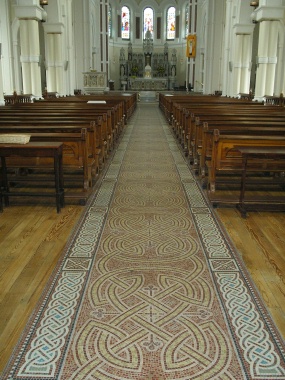
When you come into the church, you will be struck by the elegance of the interior design and its Celtic interlacing. The aisle is wide and has a path of mosaic worked in designs taken from the Book of Kells. It directs us to the Sanctuary. The altar rails, donated by the first Parish Priest, Fr. John Byrne, in memory of his parents, are of white marble and are decorated with green, brown, terracotta and ochre marble. As we walk up the aisle let us say a prayer in thanksgiving for all those who went before us and who built this beautiful church and kept it open – all our ancestors in faith.
3. The Sanctuary Area
The three things to note in the Sanctuary are:
The Presidential Chair
The Small Ambo and
The Altar.
At these three places the Eucharist, the source and summit of the Christian life, is celebrated.
Presidential Chair –
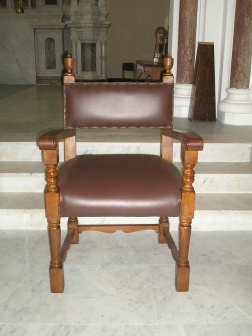 From here the priest presides over the assembly and directs the prayer of the Eucharist. He is the leader of the community at prayer and therefore symbolises the presence of Christ among the people.
From here the priest presides over the assembly and directs the prayer of the Eucharist. He is the leader of the community at prayer and therefore symbolises the presence of Christ among the people.
Ambo –
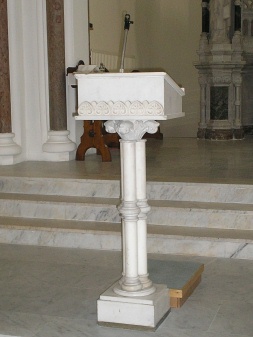
Here God’s Word is proclaims – First Reading; Psalm, Second Reading, Alleluia and Gospel, Homily. Let us pray that we will become more aware of God’s Word – that we will read and listen to the Gospels more attentively and hear Good News in our lives every time it is proclaimed.
The Altar
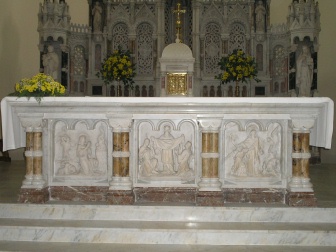
The Altar is a place for both the Holy Sacrifice and the Sacred Banquet. We recall the Lord’s Supper where we represent the death of Jesus on Good Friday and His Resurrection on Easter Sunday. The Altar Stone is a thing of beauty, representing the rock of salvation, the table at which bread and wine are transformed into Christ’s Body and Blood. As well as three vital elements, you can prayerfully reflect on a number of other items in or near the Sanctuary.
The Pulpit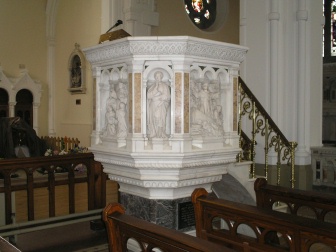
The Pulpit is just outside the altar rails, made of white marble and depicting the life of St. Columba. Of particular interest is the carving of the Saint and his Monks ailing to the island of Iona. You will also see St. Columba preaching the Gospels. Let us pray, through the intercession of St. Columba, for our parish, that the Lord will help us to listen to His Word, to put it into practise and to be more attentive to the reading of the Gospel.
The Tabernacle
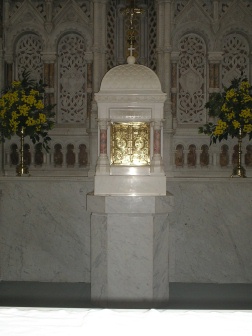
In the Tabernacle you will find the consecrated Body of Christ. This is used for quiet reflection, prayer in front of the Blessed Sacrament and also for bringing the Holy Eucharist to the sick and housebound. Let us pray for all the sick of our parish, for all those who care for them and for all those was are in hospitals or nursing homes.
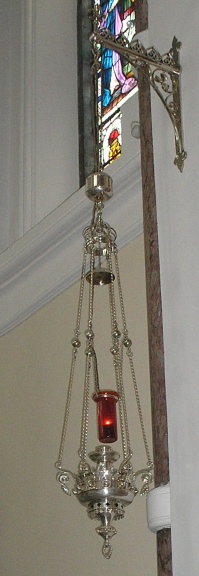 The Santuary Lamp
The Santuary Lamp
The Sanctuary Lamp – the two red lamps
either side of the Tabernacle indicate
that Jesus Christ is truly present in this
church in the Tabernacle.
Over the High Altar are seven windows of stained glass representing the Seven Sacraments. They are;
Baptism
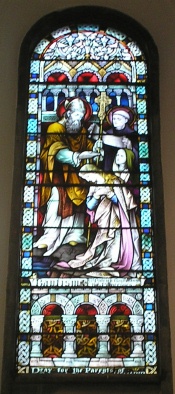
Baptism –
St. Patrick baptises the Princesses
Ethna and Fidelma. Let us pray for all
those who have been baptised in this
church since 1905.
Confirmation
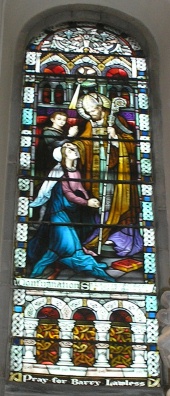 Confirmation – St. Laurence O’Toole
Confirmation – St. Laurence O’Toole
confirms a candidate. Let us pray for all
those who have been confirmed and for
those who make the sacrament of
confirmation from our schools and other
places each year. We pray that they will
see Confirmation as another step in the
commitment to Jesus Christ.
Penance
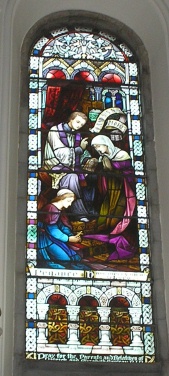
Penance – Sins are forgiven. Let us pray that
we will appreciate more and more the
mercy of God who, despite our sinfulness,
forgives us our sins and constantly gives us
second chances.
The Eucharist
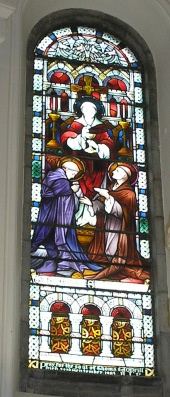 St. Columba gives Holy Communion to
St. Columba gives Holy Communion to
two of his Monks. Let us pray in
thanksgiving for the treasure of the
Eucharist and pray that we will received
it with reverence and live it in our daily
lives.
Sacrament of the Sick
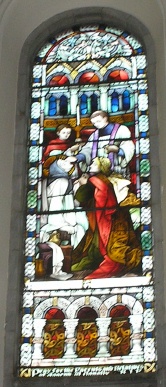
St. Bridget dies. We pray for all those who
are seriously ill and those who care for
them.
Holy Orders
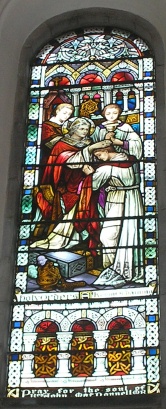 St. Kevin is ordained in Glendalough. We
St. Kevin is ordained in Glendalough. We
pray for all priests, remembering
especially those who served in this parish
and those currently serving here. We ask
the Lord to send more labourers into His
harvest.
Marriage
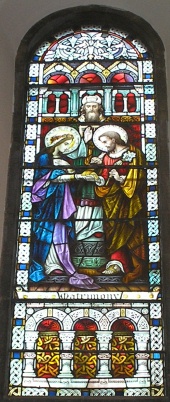
The priest blessed the espousal of Our Lady
and St. Joseph. We pray for all those who
were married in this church, for those who
are currently preparing for marriage, for
those who are in love. We remember in our
prayers in a special way those who are
widowed or separated and those who have
never married.
The Side Altars
The West Chapel is dedicated to the Sacred Heart. The main window represents Jesus with St. Margaret Mary and St. John. Beside this and over the entrance to the Sacristy is a window dedicated to the Good Shepherd.

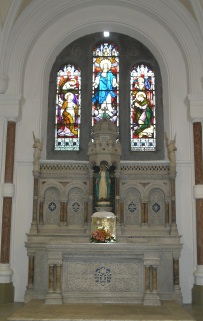
The East Chapel is dedicated to the Blessed Virgin Mary. The window, in three panels, depicts the Annunciation – I am the handmaid of the Lord. A copy of Raphael’s Madonna and Child hangs on the side wall. Let us pray through the intercession of Mary that we will be listeners to God’s Word and that we will put it into practise in our daily lives.
Adjoining the Virgin Mary Chapel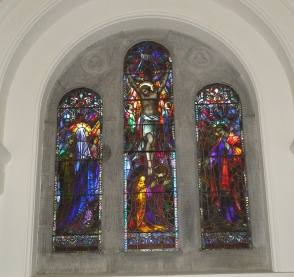
is the Book Shop. The windows in
the three panels are of the
Crucifixion. Let us pray for all
those who come into this shop to
learn more about our faith. Let us
pray for all those who
communicate the Gospel through the Word, written and spoken.
The Baptismal Font
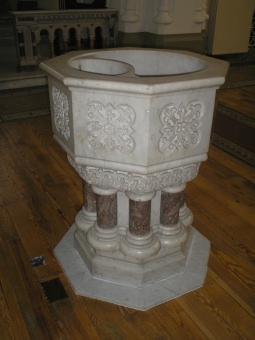
The beautiful baptismal font is now more visible and after the renovations has a gathering space around it. This enables the Christian Community to welcome with joy those who present themselves for baptism, their parents, godparents and friends. Around the font, the baby is baptised with water in the name of the Father, and of the Son and of the Holy Spirit. Let us remember all those who have been baptise at this font and those who are preparing for baptism. Let us ask the Lord to bless parents and to help them to realise more and more that baptism is not just a one-day event but is an opportunity to introduce a new generation to Jesus Christ and his Church.
Confessionals
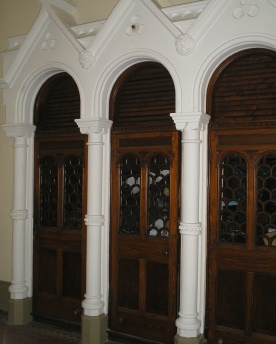 When a person approaches the priest
When a person approaches the priest
and asks for forgiveness, the priest
extends his right hand over the
penitent and forgives them in the
name of Jesus. Let us pray that we
will appreciate more and more God’s
mercy and be slower to criticise the
faults and failings of others.
The Statues
Around the walls are shrines with statues of St. Therese, the Little Flower, St. Anthony, St. Joseph, St. Bridget and St. Patrick. Lighting a candle to the Saintes has long been part of the Catholic tradition. The flame flickering for hours after the person leaves the Church symbolises the person’s prayer continuing. Lighting a candle is a sign of hope. Let us pray that as we light the candles to the Saints, we may also light candles of hope and encouragement by the words we use too others.
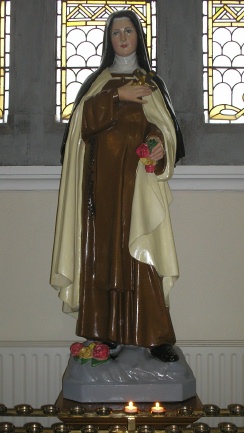
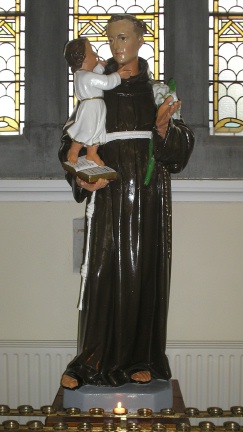
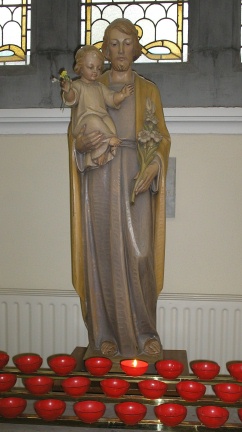
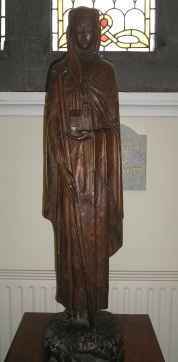

Icons
These two icons were commissioned for the re-opening of the Church in 2007. They depict St. Columba and Blessed Columba Marmion. St. Columba, the patron of our parish, was a founder of monasteries, a teacher and a reconciler who eventually set up a famous community in Iona. Let us ask him to look over our parish and to bless us as we gaze on his Icon.
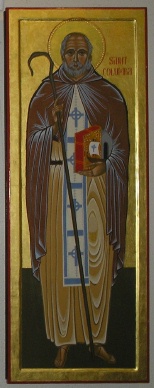
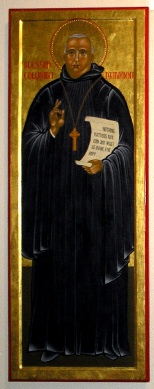
Blessed Columba Marmion, baptised in St. Paul’s Church, Arran Quay, was a priest of the Archdiocese of Dublin, who was a Chaplain to the Redemptistine Sisters in St. Alphonsus Road. Many times he walked in this area. He left the Diocese to become a Monk in Belgium. Eventually becoming Abbot of the Monastery of Maredsous. He was beatified by Pope John Paul II in 2000. We pray though the intercession of Blessed Columba for our parish and its future that we may learn from him to be people of the Gospel, of prayer and of service to our brothers and sisters, especially the poor and the weak.

